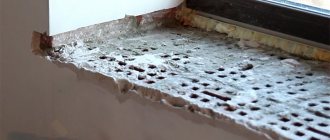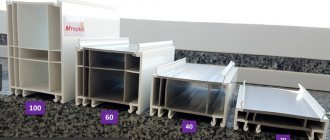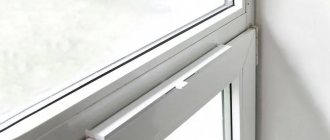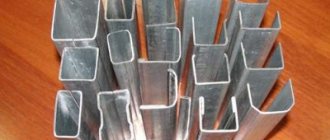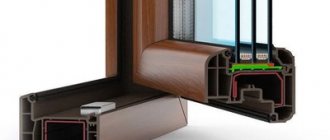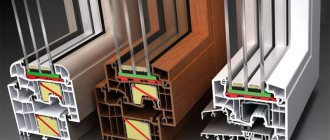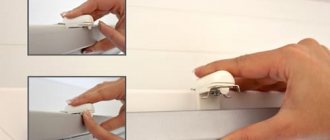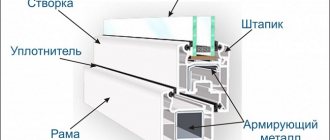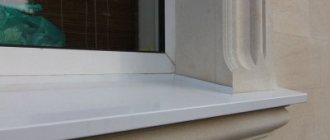Sometimes, due to installation features, when finishing the surfaces adjacent to the window, the base width of the main frame profile is not enough - most often this situation occurs when glazing balconies and loggias. In this case, it is possible for plasterboard and other facing materials to overlap glazing beads or even double-glazed windows. This cannot be allowed. It’s even worse when the top trim prevents the sash from opening normally in any of the planes. In all of these situations, it is additional profiles that allow you to get out of a difficult situation without any negative consequences. Before the advent of these universal and very necessary elements, installers and property owners often experienced difficulties, and until the developers of profile systems found a simple and effective solution, the operational and aesthetic characteristics of window structures suffered.
What is an additional profile?
An additional profile for plastic windows
is a molded PVC product that is hollow inside, which is attached to the window frame along its outer perimeter and allows you to increase the total area of the structure. Absolute tightness of the connection is ensured by a special locking connection. The groove-to-groove fixing system makes the extended window structure completely moisture- and airtight. In addition to tightness, additional elements have another important advantage - they are available in models with different thicknesses:
- 20 mm;
- 40 mm;
- 100 mm.
The ability to choose the most suitable size for “extension” provides more options for installers and builders. Some manufacturers of window profiles have decided to expand the range of these additional elements by releasing models with a thickness of 30; 45 and 60 mm. This allows for the “jewelry” integration of window structures in complex situations.
Moldings for window profile systems can also be interconnected, making it possible to extend frames in a wider range of sizes. However, this opportunity should not be abused.
How to choose a manufacturer
The quality of the installed window structure is undoubtedly influenced by accurate measurements and installation carried out in accordance with GOST by qualified employees. After all, it is during the process of measuring the window that the required dimensions and quantity of the additional profile are calculated, and during the installation process the elements are hermetically sealed.
When choosing a manufacturer, it is recommended to give preference to reliable companies with extensive experience in this field.
Scope of application of additional profiles for windows
There are many situations when an additional profile is extremely necessary, thanks to which it is possible to install windows without problems, as well as to subsequently finish slopes and other surfaces with various building materials. The scope of application of these products is not limited, and they are used wherever, for various reasons, it is necessary to expand the frame. Most often, a plastic additional profile is required when:
- The loggia and balcony are being glazed, and a decision has been made to cover the ceiling with clapboard or plastic;
- it turned out that the dimensions of the window opening are larger than the dimensions of the frame;
- it is necessary to insulate the slopes and also sew them up on the inside with plasterboard;
- it is necessary not only to build up the structure, but also to increase its rigidity.
Extenders, like the main PVC profile, can be covered with decorative films, making them suitable for increasing the area of laminated windows. When connecting such profiles, you must carefully monitor the joining line, since a white stripe may appear at the slightest shift. Usually such flaws are eliminated by painting over with a special marker.
When to apply
The profile can be used in various cases. It is most often used for glazing loggias, especially if subsequent finishing involves insulation, and the standard frame size for finishing work is not enough. In this case, the extensions are attached to the top or side of the frame so that the trim does not interfere with the opening of the window sashes. The use of such elements in installation allows us to ensure compliance with all technological requirements for the installation of structures.
In addition, opening and closing the doors will become more convenient. Installed expanders make it possible to subsequently finish the interior walls using plasterboard, lining or other materials. Installation of a suspended or suspended ceiling is allowed. Any finishing will not interfere with the normal operation of the sashes. Extensions are used to increase the surface area of a plastic window frame.
This profile is often used for complex installations of large windows or structures with deep quarters.
Window openings with deep quarters are found in old houses with thick brick or Stalin walls. Despite modern construction technologies, the geometry of window openings is often distorted, this is especially true for brick houses.
Gaps between the edge of the window frame and the edge of the window opening are not allowed. If they are present, heat loss in the room will increase. To eliminate them, increase the size of the box or use additional profiles during installation.
Related article: Kitchen layout with a window in the middle
Extensions are used to decorate various pediments, arched openings or structures of complex unusual shapes. With the help of such elements in construction, you can seal any area of the surface. For example, when covering with siding, when it is necessary to create a finished look for the entire structure, an additional profile is used to seal cracks and install cladding with a uniform structure.
Additional types of expanders
Window extensions are not only elements that allow you to extend the frame around the perimeter. Manufacturers of PVC systems also produce other auxiliary profiles that make it possible to assemble complex structures.
Connecting profiles
The PVC window extender is also used for joining frames. These elements are called connecting profiles, since they are designed for the manufacture of a complex enlarged structure from individual blocks located in the same plane. This expander for plastic windows comes in 3 types:
- connecting profile with air chamber or central plate;
- noodles – universal expander;
- H-connector - this addition to PVC windows is a thin strip that looks like an I-beam.
These elements are often used in the manufacture of balcony blocks when it is necessary to connect door and window frames. They are also necessary when performing strip glazing.
In all cases, the extension of structures is carried out by rigidly joining the frames of adjacent blocks using a screw anchor connection.
Stand profile
This PVC extender is a window profile that is fixed in the lower area of the frame. It performs several functions:
- lifts the structure above the lower end of the opening and protects the assembly seams from moisture;
- facilitates the process of installing the window sill and ebb;
- serves as an additional stiffening rib.
In addition, using a stand profile you can extend the frame. This additional profile for plastic windows increases their height by 20-30 mm.
Bay windows and corners
This profile for plastic windows is used for glazing balconies, bay windows and making entrance lobbies, as well as in the process of assembling polygonal structures. The use of bay windows allows for extensions in different planes. Such extensions are also attached to plastic windows using screw anchors. They ensure tightness of the connection and stability of shape. There are 2 types of profiles for making complex joints:
- pipe – consists of an element with a circular cross-section (pipe) and an adapter, which can change the angle of contact until final fixation;
- square - a profile with grooves for connecting two blocks at an angle of 90°.
Using these profiles, massive structures are assembled, so they all have internal chambers for reinforcement. They also have auxiliary elements for high-quality waterproofing, which helps to avoid icing of joints from the inside and damage to connecting seams.
Types of add-ons
Depending on the purpose, the following groups of products are distinguished:
- Connecting profiles are used to fasten several elements of window structures together in long openings.
- Expansion elements are used to install PVC windows in old houses with thick brick or steel walls. They cannot be glazed using products of standard thickness, but expansion elements increase the thickness of the window frame to the required dimensions.
Stand products are used when adjusting the installation height of a window structure. Plastic elements are attached to the bottom of the main frame. They raise it to the required level. Often used in old-style houses, where window openings have a quarter of different depths.- Additional H-shaped elements are designed to increase the load-bearing capabilities of large-sized window structures with sliding sashes. Increased strength characteristics are ensured by the use of metal inserts.
- Corner elements are used to eliminate gaps. They are formed as a result of dismantling used wooden frames. Provides quick assembly of structures.
Based on the shape of finished products, the following groups are distinguished:
- The J-profile has a curved shape. Often used for decorative finishing of a room, it can be combined with spotlights;
- H-profile is a corner element. Typically, such plastic profiles are installed overlapping and joined to the main structure along the entire length;
- F-profiles are widely used. They are used when cashing windows, located in the corners of the opening or used as elements to complete the installation.
Brands of additional profiles
Additional elements for PVC windows have a limited scope of application. Most profiles of the same brand are combined with each other, but there are exceptions. Typically, manufacturers make universal extenders that are suitable for different systems with the same installation depth. That is, if a brand’s assortment includes several series of profiles with system depths of 58 and 70 mm, they produce two types of extensions for them. When choosing a brand of profile system, it is recommended to immediately find out whether the product range includes plastic accessories for windows. Typically, managers of responsible companies inform their clients about the presence of auxiliary elements. However, when ordering, different situations arise, so it is recommended to study PVC profiles for windows from well-known brands.
REHAU additional profiles
It is not for nothing that this German PVC profile for plastic windows is in high demand in our construction market. The company from Germany offers customers not only a large number of systems with different characteristics, but also auxiliary elements for increasing the size of frames, as well as assembling complex structures. Accessories for REHAU plastic windows have the same characteristics as the systems themselves. To extend frames, the company offers 5 extenders with section heights of 10, 20, 40, 60 and 100 mm. All of them are compatible with systems having installation depths of 60, 70 and 86 mm. Thanks to this, you can solve any problem when installing windows in different openings. Extensions with a height of 10 mm are produced only for profiles with an installation depth of 60 mm. The expanders are installed on the frames by slotting. The resulting joints do not allow air and water to pass through, having excellent tightness. Expansion extensions for REHAU PVC windows are supplemented with bay window elements - a corner and a pipe. The range also includes a fixed 130 degree connector. It has a limited scope, but is sometimes necessary when assembling complex bay windows. All Rehau auxiliary elements have internal chambers into which reinforcing liners made of galvanized steel with a wall thickness of 1.5 mm are placed.
Additional KBE profiles
KBE plastic systems are also popular on the Russian market. Profiles of this brand have installation depths of 58, 70, 76 and 88 mm. Additional elements for KBE plastic windows are represented by a standard set of elements - extenders, connectors, bay windows and corners. The company has supplemented the standard set with adapters that allow you to assemble complex structures from any PVC systems of this brand.
Universal additional profiles
Since most companies assemble windows from systems of different brands, there is a need for universal auxiliary elements. Their presence would expand the opportunities for both sellers and buyers. Currently, universal accessories for plastic windows have been developed, in the manufacture of which the systems MONTBLANC, GOODWIN, ARTEC, KBE, VEKA, REHAU, WINTECH, BAULINE, ALUPLAST, KRAUSS, ECP, PLAFEN, PROPLEX, NOVOTEX, EXPROF are used. The condition for using universal profiles is that the system depth matches.
External fittings
Handles for PVC windows must be reliable and made from durable material, because they are often used. Also, window handles are an indispensable element that complements any interior design well. They are often used for active ventilation of rooms. Window handles are made from different materials, then treated with special compounds that protect them from various types of damage.
Types of window handles:
- Single sided handles.
Double-sided handles.
Additional profile classes
All plastic connectors, bay windows, corners and extenders that are used in the assembly of plastic windows are subject to the requirements of the updated GOST 30673-2013. According to them, the additional PVC profile is divided into 3 classes:
- “C” - products in this category were manufactured without meeting certain requirements and are not used today for assembling windows;
- “B” - the thickness of the outer walls cannot be less than 2.5 mm, and the inner walls - 2 mm;
- “A” - the best profiles with a thickness of external walls from 3 mm and internal walls from 2.5 mm.
The standards also set requirements for frost resistance, energy efficiency, heat resistance, ability to withstand impacts and permissible changes in linear dimensions. In fact, auxiliary plastic elements have the same characteristics as the main PVC systems for assembling profile structures. Such strict requirements are explained by the fact that they are an integral part of window and door units.
The additional profile for windows must be reinforced. The presence of steel reinforcing liners is necessary not only to increase the overall rigidity of the window structure, but also to ensure the reliability of the connection. After all, expanders are attached to frames using special self-tapping screws, so metal elements in adjacent profiles allow for high-quality joining of individual elements of the window structure.
Product quality requirements
Additional elements must be manufactured in compliance with all technical regulations for the production of plastic windows, similar to the main window profile. At the customer's request, the profile is installed in the color of the main window structure.
For products that are used in external glazing, where structures are subject to freezing at subzero temperatures, the presence of reinforcement is mandatory. If available, the steel profile inside the products will provide the necessary rigidity during cold periods of operation. Reinforced products can be distinguished from parts without reinforcement by the side section, where all the components of the profile are visible.
Color of auxiliary profiles
Expanders and connectors of blocks made of PVC profiles are painted and subjected to lamination, so they do not differ in appearance from the main structures. The additions to plastic windows, photos of which show decor options, can be white or colored in the paste. In standard situations, cream or brown profiles are recommended for applying wood-like films. However, in the case of extensions, you can choose a less expensive white base, since all visible parts of the auxiliary profiles will in any case be covered with films.
Dimensions and fastening of elements
Standard plastic accessories have the following dimensions:
Products from different manufacturers may differ in width. To obtain a non-standard thickness of the trim, you can connect several elements together. Additional profiles have special grooves with which they are attached to each other, which ensures ease of installation. The extensions must be attached to the main structure with self-tapping screws or other fastenings, which will ensure the necessary strength of the connection. Otherwise, over time, gaps may appear between the main window structure and additional elements. To increase thermal insulation, thermal insulation tape can be glued at the joints.
When combining elements in one place on the wall, the length of the extension will correspond to the height of the wall. When using several connecting sections, the length is determined by calculation.
Price of additional profiles
The cost of original expanders, connectors, corners and bay windows depends on the class and brand of profiles. The price is also influenced by the dimensions and shape of the section. The most expensive are bay window systems consisting of a pipe and an adapter. The least expensive is the (stand) additional profile for plastic windows, which is installed in the lower zone of the frames.
| Profile brand and mounting depth | Interframe connector (rub.) | Extender Н=20/30 mm (rub.) | Extender Н=60 mm (rub.) | Extender Н=100/120 mm (rub.) | Angle (rub.) | Ereker (rub.) | Stand profile (RUB) |
| REHAU 60 | 215 | 250 | 515 | 585 | 400 | 700 | 50 |
| KBE 58 | 50 | 85 | 215 | 330 | 250 | 425 | 20 |
When calculating the cost of these components, you need to take into account that PVC window frames are most often sold without reinforcing liners. These items must be purchased separately. Their price depends on the thickness of the steel sheets from which they are made, the cross-sectional shape and the quality of galvanization.
Mosquito net
These components for PVC windows are considered optional for installation, but they protect the room in the summer from various insects, so consider their quantity and necessity when putting together the kit. The mesh has a small thickness. They can be easily dismantled for autumn and winter.
Some varieties, in addition to their protective functions, also prevent pets from falling out of the room.
There are the following types of meshes:
Slopes
These components for PVC windows are used for interior decoration and cover the entire space of metal-plastic structures. The main purpose of these components is to close the mounting seam of the frame with the window opening. They have a small thickness. Most often, slopes are used to finish the window at the final stage, which makes the window opening attractive.
Today, plastic slopes are considered the most beautiful, cheapest and most reliable. Their advantages are quick installation and thermal insulation. These components do not require special care and are not mechanically damaged.
Aesthetic moment
An element of beauty and addition to the design is the plastic corner. A window corner is made from PVC by bending a hot sheet, which has a small thickness. The corner is used when installing slopes. It closes the gap between the plastic structure, the construction quarter and covers the mounting foam, protecting against various harmful influences.
The corner is not only strong, but also durable. It gives the same features to slopes. The corner also smooths out all the unevenness in the corners.
